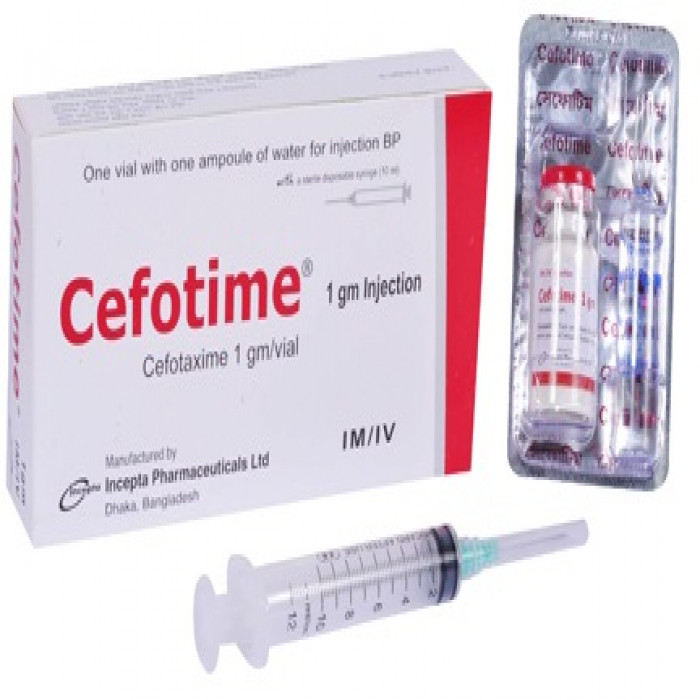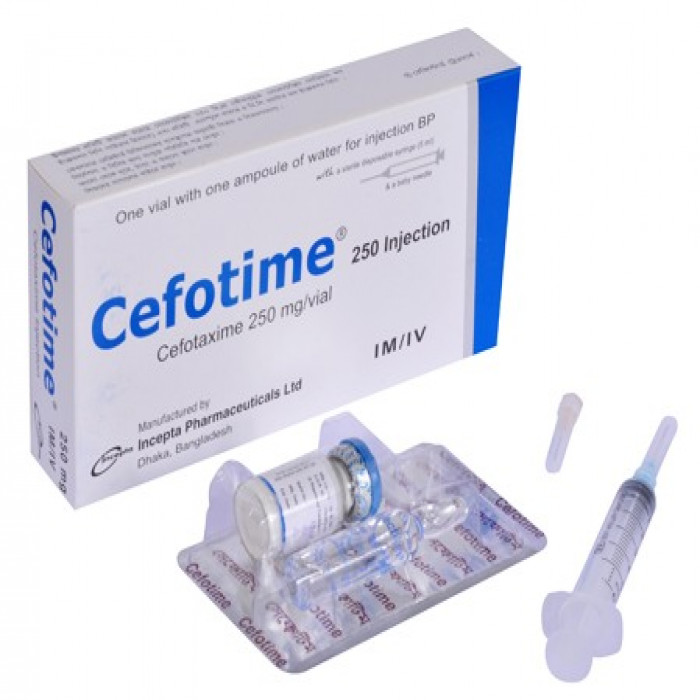
✔ 100% Authentic Product
👁️ Currently Viewing 1369
Cefotime IV/IM 1gm Injection
Injection, Generic Name: Cefotaxime Sodium, Manufacturer: Incepta Pharmaceuticals Ltd.
Discount
Price: ৳ 141
MRP:
৳
150
6%
Off

100% Genuine Products, Guaranteed

Safe & Secure Payments, Always

Fast, Secure & Efficient Delivery

Proper Packaging
 Cash on Delivery - All over Bangladesh
Cash on Delivery - All over Bangladesh Regular Delivery - 12-24 Hours, Dhaka City* Charge Tk.39-59
Regular Delivery - 12-24 Hours, Dhaka City* Charge Tk.39-59 Regular Delivery - 24-48 Hours, Other Cities* Charge Tk.99-110
Regular Delivery - 24-48 Hours, Other Cities* Charge Tk.99-110
 ফ্রি ডেলিভারিঃ - ৯৯৯ টাকা+ অর্ডারে, ঢাকা
শহরে
ফ্রি ডেলিভারিঃ - ৯৯৯ টাকা+ অর্ডারে, ঢাকা
শহরে ফ্রি ডেলিভারিঃ - ২৯৯৯ টাকা+ অর্ডারে, ঢাকার
বাহিরে
ফ্রি ডেলিভারিঃ - ২৯৯৯ টাকা+ অর্ডারে, ঢাকার
বাহিরে
100% Genuine Products, Guaranteed
Safe & Secure Payments, Always
Fast, Secure & Efficient Delivery
Proper Packaging
 Cash on Delivery - All over Bangladesh
Cash on Delivery - All over Bangladesh Regular Delivery - 12-24 Hours, Dhaka City* Charge Tk.39-59
Regular Delivery - 12-24 Hours, Dhaka City* Charge Tk.39-59 Regular Delivery - 24-48 Hours, Other Cities* Charge Tk.99-110
Regular Delivery - 24-48 Hours, Other Cities* Charge Tk.99-110 ফ্রি ডেলিভারিঃ - ৯৯৯ টাকা+ অর্ডারে, ঢাকা
শহরে
ফ্রি ডেলিভারিঃ - ৯৯৯ টাকা+ অর্ডারে, ঢাকা
শহরে ফ্রি ডেলিভারিঃ - ২৯৯৯ টাকা+ অর্ডারে, ঢাকার
বাহিরে
ফ্রি ডেলিভারিঃ - ২৯৯৯ টাকা+ অর্ডারে, ঢাকার
বাহিরে
✅ Description:
Indications of Cefotime - IV/IM Injection
Cefotaxime is used to treat the following infections, either before the infecting organism is discovered or when bacteria of known sensitivity are involved: Septicaemia Acute or chronic bronchitis, bacterial pneumonia, infected bronchiectasis, lung abscess, and surgical chest infections are all examples of respiratory tract infections. Acute and chronic pyelonephritis, cystitis, and silent bacteriuria are examples of urinary tract infections. Infections affecting the soft tissues, such as cellulitis, wound infections and peritonitis Infections of the bones and joints, such as osteomyelitis and septic arthritis Infections of the obstetric and gynecological systems, such as pelvic inflammatory disease Gonorrhoea, especially when penicillin has failed or is no longer effective. Meningitis and other sensitive infections that require parenteral antibiotic therapy are examples of other bacterial infections. Prophylaxis: In patients having surgical procedures that are classed as contaminated or possibly contaminated, or in clean operations where infection would have catastrophic consequences, prophylactic injection of Cefotaxime may minimize the occurrence of certain post-operative infections.
Pharmaceutical Name of Cefotime - IV/IM Injection
Pharmacology
Cefotaxime binds to one or more penicillin binding proteins (PBPs), which block the last transpeptidation step of peptidoglycan production in the bacterial cell wall, halting biosynthesis and resulting in bacterial cell death. Cefotaxime is a bactericidal 3rd generation parenteral cephalosporin antibiotic with a broad spectrum of activity. Cefotaxime is particularly effective against gram-negative bacteria that are susceptible to or resistant to first-generation or second-generation cephalosporins. In terms of activity against gram-positive bacteria, it is similar to other cephalosporins.
Dosage & Administration of Cefotime - IV/IM Injection
Adults: The recommended dosage for mild to moderate infections is 1 gm every 12 hourly. However, dosage may be varied according to the severity of infection, sensitivity of causative organisms and condition of the patient. In severe infections dosage may be increased up to 12 gm daily given in 3 or 4 divided doses. For infections caused by sensitive Pseudomonas spp. daily doses of greater than 6 gm will usually be required
Children: The usual dosage range is 100-150 mg/kg/day in 2 to 4 divided doses. However, in very severe infections doses of up to 200 mg/kg/day may be required.
Neonates: The recommended dosage is 50 mg/kg/day in 2 to 4 divided doses. In severe infections 150-200 mg/kg/day, in divided doses, have been given.
Dosage in gonorrhoea: 500 mg as a single dose.
Interaction of Cefotime - IV/IM Injection
Ceftibuten's pharmacokinetic profile is unaffected by theophylline or antacid. Ceftibuten's Cmax and AUC are increased by ranitidine.
Contraindications
Cefotaxime is contraindicated in patients who have shown hypersensitivity to cefotaxime or the cephalosporin group of antibiotics.
Side Effects of Cefotime - IV/IM Injection
Cefotaxime has been linked to a small number of adverse effects, all of which have been moderate and temporary. Candidaemia, rashes, fever, transitory increases in hepatic transaminase and/or alkaline phosphatase, and diarrhoea have all been recorded as side effects. Pseudomembranous colitis, like all cephalosporins, can occur infrequently during treatment. If this happens, the medicine should be stopped and a special treatment plan should be implemented. Changes in renal function have been reported seldom with high doses of Cefotaxime, like with other cephalosporins. The use of large doses of cephalosporins, especially in patients with renal failure, can cause encephalopathy. There have been reports of hypersensitivity reactions.
Pregnancy & Lactation
Although no harmful effects on the developing foetus have been shown in animal investigations, the safety of Cefotaxime in human pregnancy has not been demonstrated. As a result, Cefotaxime should not be used during pregnancy, particularly during the first trimester, unless the projected benefit is carefully weighed against the potential dangers. Cefotaxime is a drug that is excreted in milk.
Precautions & Warnings
Cefotaxime should be used with caution in people who have had gastrointestinal disorders, especially colitis. Because typical doses of Cefotaxime can result in high and sustained antibiotic concentrations in patients with temporary or permanent reductions in urine output due to renal insufficiency, the total daily dosage should be lowered when Cefotaxime is given to such individuals. The dosage should be determined by the severity of the illness, the degree of renal impairment, and the susceptibility of the pathogenic organism. There is no clinical evidence that modifying Cefotaxime dosage in patients with even severe renal impairment is necessary.
Storage Conditions
Store at a temperature below 25°C, away from light and moisture. Suspension: After reconstitution, the suspension can be stored at 2° to 8°C for 14 days. Keep out of children's reach.
⚠️Disclaimer:
At ePharma, we’re committed to providing accurate and accessible health information. However, all content is intended for informational purposes only and should not replace medical advice from a qualified physician. Please consult your healthcare provider for personalized guidance. We aim to support, not substitute, the doctor-patient relationship.








